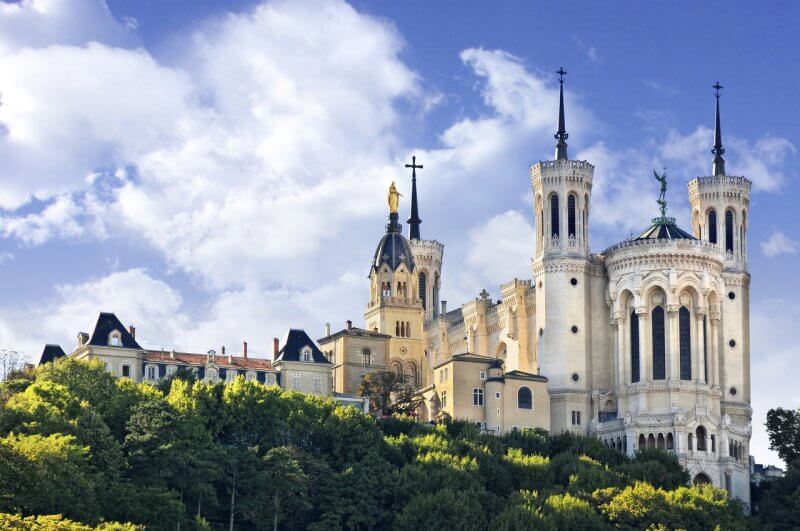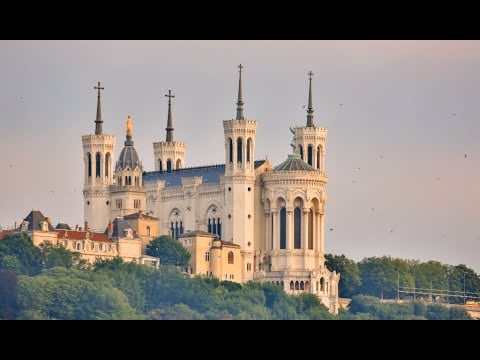Over the centuries, the Basilica of Notre-Dame-de-Fourvieres has always attracted the attention of many pilgrims, and it still receives more than 2.5 million visitors annually. This shrine, which stands on top of the Fourviere hill, seems to tower over Lyon and is visible from every corner of it.
Historical background
The history of the modern basilica dates back to 1168, when a temple was built on the Fourviere Lyon hill. In the XVI century, the temple was destroyed by the Huguenots, only the chapel survived-it still stands on the south side of the temple.

In 1830, the chapel was dismantled, as it became so dilapidated that it could collapse at any time. But it was recreated in its original form, and in 1843 a statue of the Virgin Mary was placed on top. It was erected in gratitude to the Mother of God for listening to the prayers of the citizens and protecting Lyon from the monstrous plague epidemic that raged in 1643. The epidemic stopped very soon. After the coronation of the statue, held in 1852, on December 8, Lyon began to celebrate the Festival of Light every year.
In 1870, people again turned to the Most Holy Theotokos, and she again heard their prayer. By this time Bismarck’s army had captured Paris and was almost upon Burgundy, and the people of Lyons gathered on the hill to plead for the protection and safety of their city. And the archbishop even swore that people would build a new church in honor of the Mother of God on this site. And after a couple of days, the Prussian army retreated. When the war ended, the townspeople raised funds for the construction of the basilica.
The new church was designed by Pierre Bossan. He made his first sketches long before all these events took place, back in 1846.
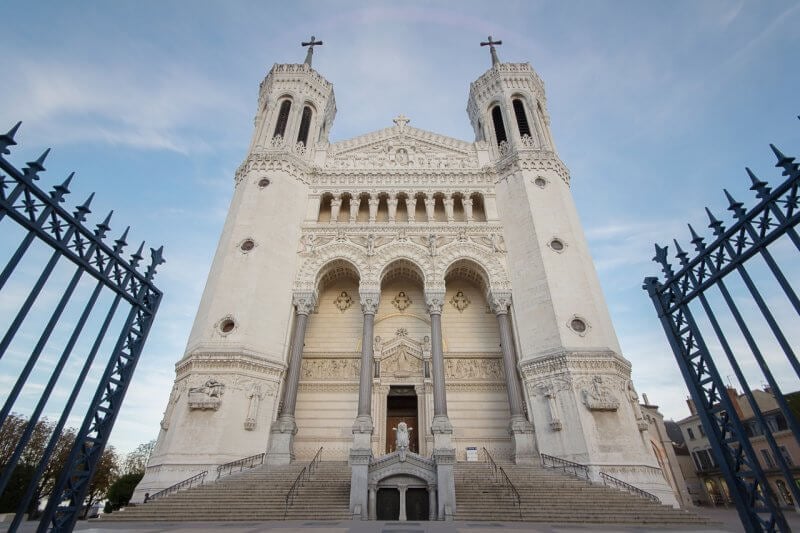
The construction of Notre-Dame-de-Fourviere began in 1872, and was completed in 1884 (although according to some sources, the completion of work falls on 1876 or 1896). As for the interior design, they were able to complete it only in 1964.
The new church was consecrated in 1896, given the status of a basilica in 1897, and the first mass was celebrated there in 1890. In 1998, the Fourviere Basilica, as part of historic Lyon, was designated a UNESCO World Heritage Site.
Architecture of Notre-Dame-de-Fourvières
The architecture of the Basilica de Fourvières combines elements of Byzantine, Gothic and Romanesque styles.
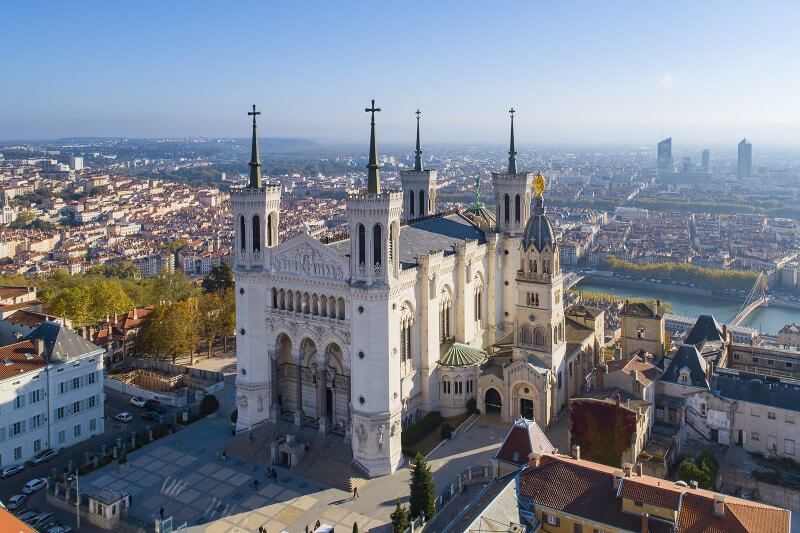
The structure is 86 meters long and 35 meters wide.
The building has 4 cylindrical towers with a height of 48 meters. Two of them face towards Lyon, with the north-eastern one symbolizing Prudence, and the south-eastern one-Moderation. The other two tower over the square, the north-western one is the personification of Strength, and the south-western one is Justice.
Interior decoration of the Basilica
The Basilica of Notre-Dame consists of two churches, which are located one above the other. The entrance to each of them is located on the side of the square.
The upper church has 3 domes, 3 large naves and 3 vaulted spans, and is supported by 16 columns. The materials used for construction and decoration seem to compete with each other in quality and beauty: pink granite, white and blue marble, green onyx, ivory, ebony, gold and silver. Sunlight enters through 6 unique large stained glass windows. On the side walls there are 6 large-scale mosaics with the Virgin Mary, the authors of which were Charles Lameyr and Georges Decota.
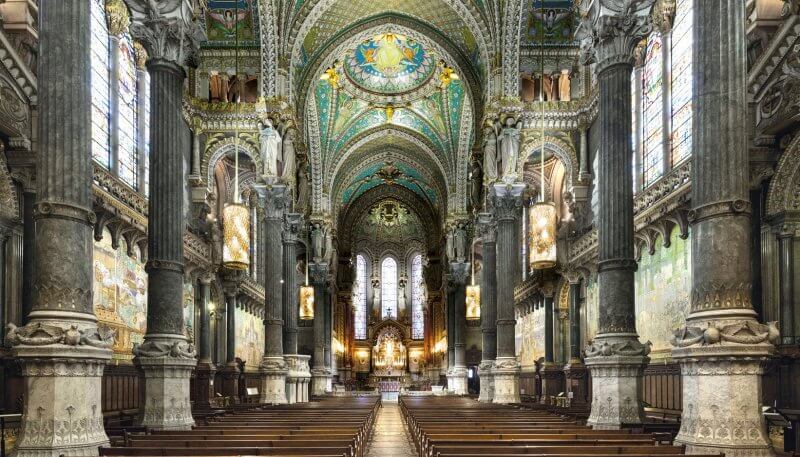
The lower church of the Basilica of Notre-Dame is dedicated to Saint Joseph. According to the architect Pierre Bossan, the pilgrim should “go to the Mother of God through Joseph”, passing from the darkness of the crypt to the light of the upper church. The Lions ‘ Door, located on the east side near the rose garden, was planned as the main entrance to the Basilica of Notre-Dame de Fourvières, but was never used as such due to impracticality. On the marble walls of the crypt are the names of the parishes that made donations for the construction.
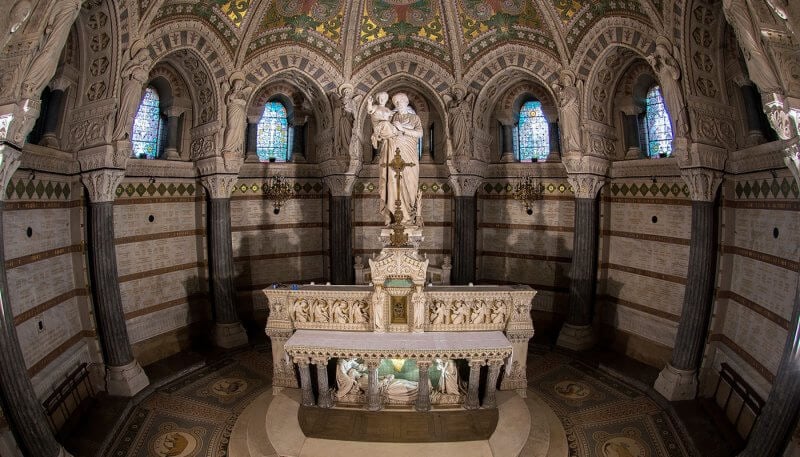
The crypt of St. Joseph is characterized by a very powerful oppressive atmosphere, which is emphasized by unfinished sculptures.
Practical information
- Address of Notre-Dame in Lyon: 8 Pl, de Fourviere, 69005.
- The entrance to the basilica and to the rosaries, to the upper church of the Virgin and to the crypt of Joseph is free of charge.
- The basilica is open daily from 7: 00 to 19: 00. Visit the rose gardens in summer from 7: 00 to 23: 00, in winter from 7: 00 to 21: 30. The car park is open from 5: 15 to 21: 30 on weekdays and from 9: 15 to 21: 30 on weekends.
- Official website: www.fourviere.org/en.
Important! It is forbidden to walk inside the basilica during Mass!
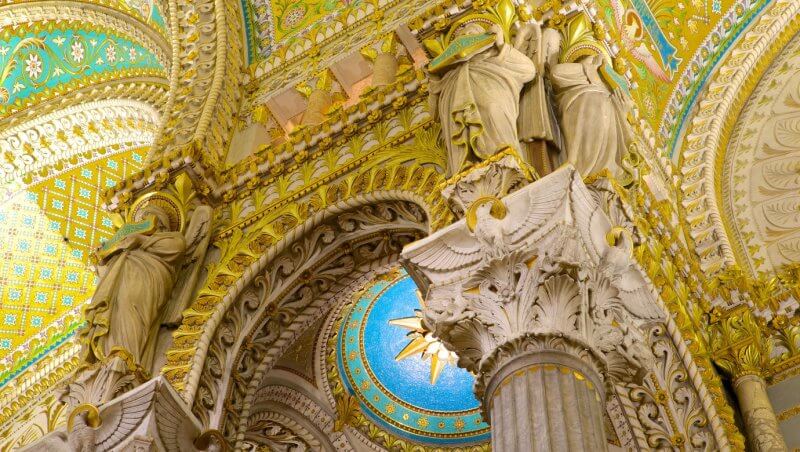
On the territory of the shrine there is an information point, it is open from 10: 00 to 17: 00 with a lunch break from 12: 00 to 14: 00. For tourists, there are brochures with detailed historical information, they are available in 10 languages. You can also contact our volunteer guides-they will answer any questions, tell you about the history and architecture of the attraction. You can download the audio guide for free on the official website.
By the way, the St. Michael’s terrace adjacent to Notre-Dame-de-Fourvieres offers panoramic views of Lyon. And if you climb to the roof of the building, to the observatory, then Lyon will literally be “at your feet”. That’s just for this you will have to overcome 345 steps.
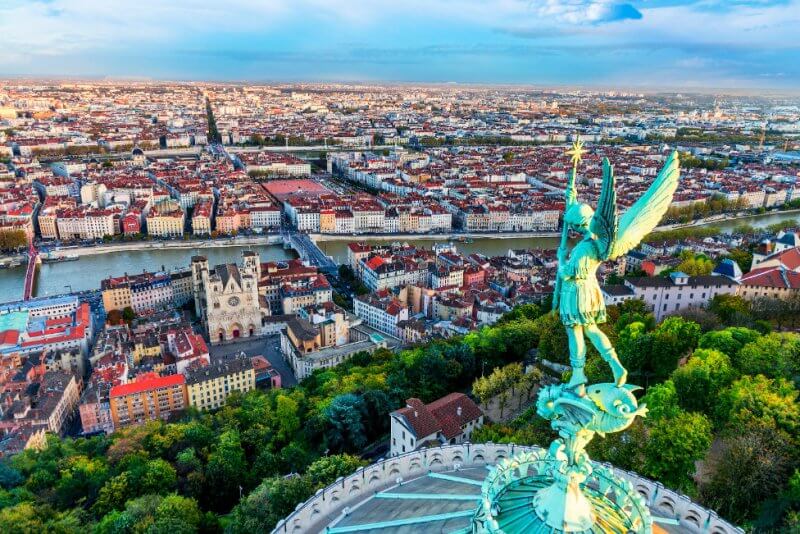
Access to the roof of the basilica is possible as part of an organized guided tour. The floating schedule is regularly updated on the Notre-Dame-Fourviere website. The duration of the tour is 90 minutes, the meeting point is on the right in front of the basilica, at the top of the steps. The ticket price for adults is 10 €, for children from 5 to 18 years-5€, for children under 5 years – free of charge.
The church has a museum of religious art, which displays exhibits from the treasury of the Basilica of Fourviere. Some of these exhibits are still used in especially solemn divine services.
Interesting facts about the Basilica of Notre-Dame de Fourvières
- In 1630, Anne of Austria came to the basilica to pray to the Mother of God for the birth of her son.
- Since 1982, the antenna of the Christian Radio of France stands at the top of the tower.
- Because of the four cylindrical towers that tower over the basilica, the inhabitants of Lyon sometimes disrespectfully compare it to an elephant turned upside down.
- Designed by the Basilica of Notre-Dame-de-Fourvieres in 1906, the church of Notre-Dame-de-Victoire was built on the territory of the French Quarter in San Francisco.
- The Fourviere Basilica is similar in architecture, construction history, and location on a hill above the city to the Sacre Coeur in Paris.
- On Friday, March 18, 2022, in the Basilica of Notre-Dame-de-Fourvieres in Lyon, they prayed for peace in Ukraine. After the mass, a servant of the basilica addressed the audience and said that every Saturday at 16:30 in the chapel of the Most Holy Theotokos they will pray for Ukraine and for world peace.
Bordeaux Region: Your Ultimate Guide to the Wine Capital

